Photography has the power to capture and freeze moments in time, preserving them for posterity. Throughout history, many photographs have become iconic, telling stories and eliciting emotions that transcend borders and generations. These images have had a profound impact on the world, shaping our collective memories and influencing our perceptions of key events and cultural phenomena. From the impactful images of war and conflict to the groundbreaking portraits that challenge societal norms, world-famous photographs have left a lasting legacy and continue to inspire future generations of photographers.
'Migrant Mother' By Dorothea Lange, 1936 / Graflex Series D
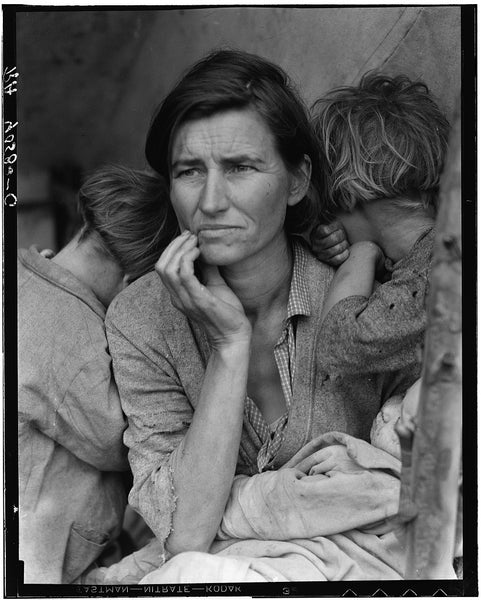
'Migrant Mother' by Dorothea Lange, 1936. Source: Library of Congress. Public Domain.
In the 1930s, at the height of the Great Depression, photographer Dorothea Lange left her job to photograph the many hopeless and grim scenes of life in America at that time. In California, on the way home from a shoot, she happened across the ‘Pea Pickers Camp’, a camp with thousands of migrant workers on the side of the road after a farming disaster had left them all without work or homes. The mother, Florence Owens Thompson, had been driving seeking work when the family car broke down near the camp. Lange photographed the pitiful scene, hoping to use it to draw attention to the plight of thousands of families across the country. The composition, with Thompson gazing despairingly off frame, epitomised the uncertainty and hopelessness of the time and became rightly iconic and timeless.
Her photograph and her wider work was fearless and faithful, and led to Lange being hired by the FSA (Farm Security Association) to travel through the country, documenting the plight of the American worker. The photograph also triggered a $20,000 food donation to the camp.
'Buzz Aldrin on the moon' by Neil Armstrong, 1969 / Hasselblad Data
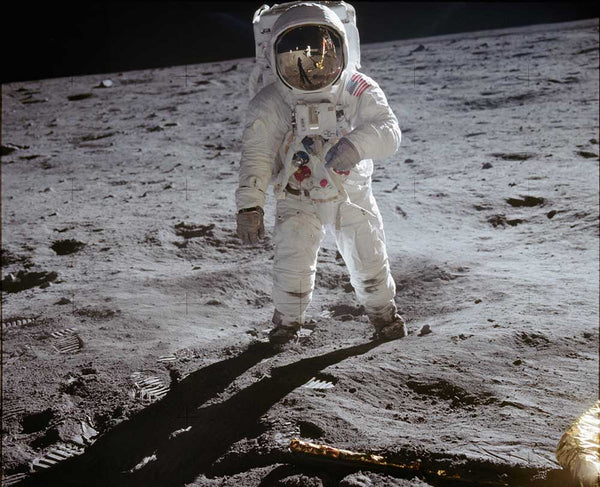
Photo of Buzz Aldrin on the Moon, taken by Neil Armstrong. Copyright NASA. Public domain.
The stunning sharpness and clarity of earlier space photographs meant that Hasselblad, the Swedish produced cameras, were the default choice for many NASA space missions, having proved their ability to withstand the rigours of wide temperature ranges, vibration and zero gravity. Any camera being taken on a space mission needed customisation however, and the silver Hasselblad Data Camera (HDC) chosen for Apollo 11’s moon landing mission in 1969 was no different. It was painted silver as a way to stabilise it when moving through extreme temperatures, and was fitted with a Zeiss Biogon 60mm lens and kitted with specially formulated thin Kodak film, allowing for up to 200 exposures.
The camera was attached to Neil Armstrong’s chest as he carefully stepped down from the lunar module onto the surface of the moon - the very first human to do so. He was followed by Buzz Aldrin, and it is he who appears in Armstrong’s photo. The photo is stunning, clear and crisp details in full colour, with the added interest of Armstrong himself appearing in the photo, reflected in Aldrin’s helmet, Earth visible behind him. All non essential equipment and material had to be discarded to save space and reduce weight for the return journey, and the camera, along with the descent ladder, scientific instruments, shoes and backpacks was left behind on the surface - but not before the precious film had been removed. Read more about the cameras left behind on the moon here.
'Raising The Flag On Iwo Jima' By Joe Rosenthal, 1945 / Speed Graphic
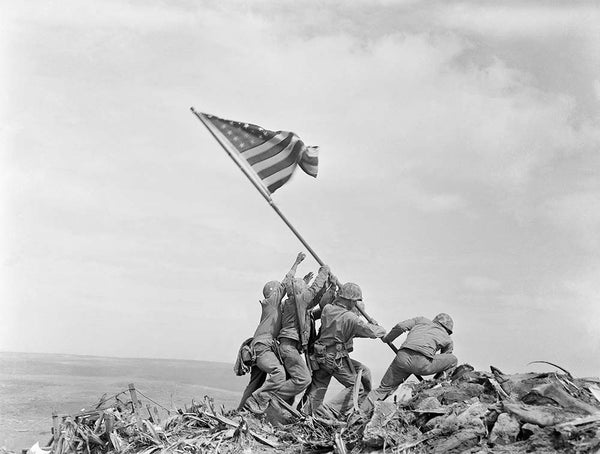
'Raising The Flag On Iwo Jima' By Joe Rosenthal, AP. Source Licence
It looks like a scene from a classic Renaissance painting, an iconic pose with a group of beleaguered fighters raising their flag aloft against the odds, flag unfurling slowly in the breeze atop a hill. When the Americans invaded Iwo Jima on 19th February 1945, it was seen as a key achievement in the war in the Pacific. It was a hard fought bloody battle for both sides, and when the Americans finally took the all important summit of Suribachi, the highest point on the island, they wasted no time in planting an American flag to signify to all below of their victory. The flag, raised by six marines - Ira Hayes, Harold Schultz, Michael Strank, Franklin Sousley, Harold Keller and Harlon Block, was a replacement for an earlier, smaller one and was photographed in a hurry by war photographer, Joe Rosenthal, who very nearly missed the shot. The photo was published by hundreds of different newspapers. Its starkness, drama and emotive quality, struck a chord with the public in how it showed the resilience and bravery of the marines.
The dramatic, almost theatrical scene gave rise to rumours that it had been staged. When Rosenthal sarcastically replied ‘Sure!’ to a question on whether he had set it up, he was unwittingly opening himself up to years of accusations and even calls for the Pulitzer Prize to be revoked.
Sadly, only three of the marines pictured - Hayes, Schultz and Keller - survived Iwo Jima. The famous photograph became not only one of the most iconic war photos ever, but also a memorial and the last known photo of Strank, Sousley and Block before they died, not long after it was taken.
Abbey Road Album Cover By Iain Macmillan, 1969 / Hasselblad
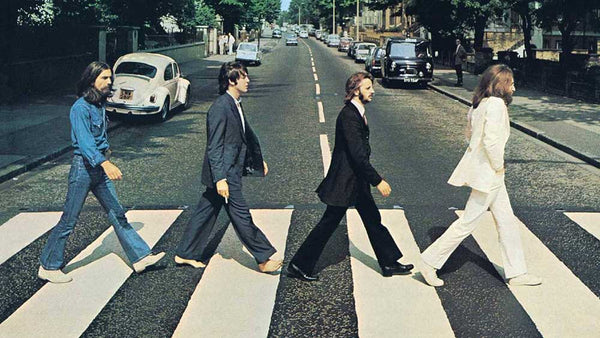
"The Beatles - Abbey Road 1969" by Photo Giddy is licensed under CC BY-NC 2.0 .
3 Abbey Road, Westminster, London is nothing less than a mecca, a must-see on any music pilgrimage to London, being the site of the recording studios of EMI Music where many iconic Beatles albums were recorded. The Beatles had decided on ‘Abbey Road’ as the title of their new album, and towards the end of the recording, arranged for a photoshoot for the cover of the album. They consulted on the photography with Iain McMillan, a Scottish photographer who had previously worked with Yoko Ono and who John Lennon asked to photograph the album cover - a shot showing the band walking across the pedestrian crossing outside the studio. The shot was tricky to arrange - the busy road had to be held up for 15 minutes while the photo was taken, with McMillann balancing atop a small stepladder while the band crossed several times to get just the right shot. It also needed all 4 band members to form a perfect v mid walk at the same time, and equidistant from each other. Luckily one of the 6 shots taken was perfect, becoming one of the most recognised images in music history.
‘Tank Man’ (or ‘Unknown Protestor’) By Jeff Widener, 1989 / Nikon Fe2
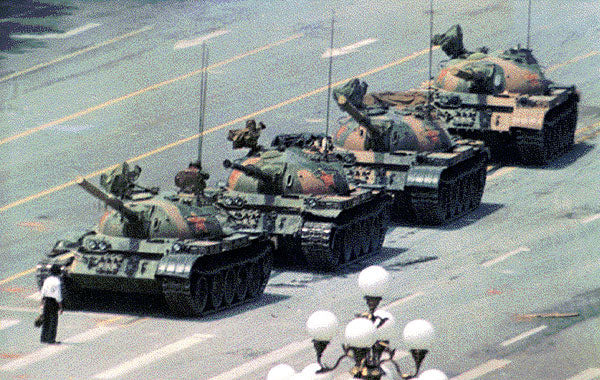
'Tank Man' by Jeff Widener, 1989. AP. Source Licence
The Tiananmen Square Massacre shocked the world in 1989. The world watched as the Chinese authorities brutally put down student-led protests at the death of the pro-democracy Hu Yaobang and demanding more government transparency. The last ditch defiance of the protestors immortalised by a lone man, standing in front of a long column of tanks. He stood right in the path of the tanks, and when they tried to go around him, he moved back into their path, obstructing their progress. The brutal suppression was immortalised by the very few international journalists and photographers in China at the time, many of whom were staying in the Beijing Hotel, located right above Tiananmen Square, including Jeff Widener. Widener’s film had to be smuggled out of China, but was processed quickly, its publication drawing unwanted international attention to the acts of the Chinese government.
‘Sharbat Gula/Afghan Girl' By Steve McCurry, 1984 / Nikon Fm2

"© Steve McCurry / Magnum Photos" by Hotels-HPRG is licensed under CC BY-NC-ND 2.0 .
The story behind the photo that stunned the world and became the most popular National Geographic photo is a complex and controversial one. Renowned American photojournalist Steve McCurry was in Pakistan in 1984, photographing in an Afghan refugee camp. He came across 12 year old Sharbat Gula in a schoolroom one day and quickly realised the potential for a stunning photo. McCurry was struck by the piercing, green eyed gaze of the child and requested some photos, moving her to a room with a cleaner background. A conservative Pashtun, Gula was reluctant, but was compelled by her teacher to lower her hands, and McCurry had only a quick few minutes to shoot her before she fled. The photographer didn’t see the results of the shoot until 2 months later, back in the United States where he was able to develop the film. The photo was instantly recognised as a knockout cover, quickly capturing the imagination of the world, and used to highlight the plight of the thousands of refugees fleeing Afghanistan.
'Burning Monk' By Malcolm Browne, 1963 / Petri

'Burning Monk' By Malcolm Browne, 1963, AP. Public Domain
The horrifying scene seems like something from a movie, almost unreal, and hard to believe that it actually happened. A monk calmly burns himself in the street, in protest over the Vietnamese government repression of those of the Buddhist faith. Following a tip from the Buddhist community, Malcolm Browne of the Associated Press was on the scene to capture the compellingly awful scene. An elderly monk, Thich Quang Duc, after being doused in five gallons of fuel, struck a match and set himself on fire at the busy Saigon intersection, in the ultimate peaceful protest at government brutality. The image is beyond awful, yet strangely beautiful, with silvery flames gracefully consuming the monk’s robes, while he sits, strangely motionless on the street. The photograph was seen around the world and was said to have been a key moment in American policy in Vietnam and anti-war protests.
